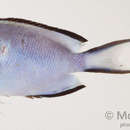mk
имиња во трошки


Genicanthus watanabei, the blackedged angelfish or Watanabe’s angelfish, is a species of marine ray-finned fish, a marine angelfish belonging to the family Pomacanthidae. It is found in the Pacific Ocean.
Genicanthus watanabei, like the other angelfishes in the genus Genicanthus, shows sexual dichromatism, the males and females show differences in colour and pattern. The males are pale blue to bluish-grey on the upper third of their bodies with the lower two thirds having 8 horizontal, thin black stripes, the highest of these end in a patch of yellow colour. The females are overall light blue colour with wide black bars across their head and a black spot on the snout. In both males and females there is a wide submarginal band on the dorsal and anal fins, and on the lobes of the caudal fin. Juveniles somewhat resemble females in colour. [3] In both sexes the forked tail narrows at its base to create a “swallow tail”.[4] The dorsal fin contains 15-16 spines and 15-16 soft rays while the anal fin has 3 spines and 14-17 soft rays. This species attains a maximum total length of 15 centimetres (5.9 in).[2]
Genicanthus watanabei is found in the Pacific Ocean. It ranges from Taiwan east to the Cook Islands and Tuamotu Archipelago, north to the Ryukyu Islands and south to New Caledonia and the Austral Islands.[1] It also occurs on the Great Barrier Reef with juveniles reaching as far south as Sydney.[3]
Genicanthus watanabei occurs at depths between 12 and 81 metres (39 and 266 ft).[1] Here can be found on the outward slopes of reefs and on drop offs where there is a strong current.[2] It feeds on plankton in the water column.[4] Like all of their congeners the blackedged angelfish is a protogynous hermaphrodite, starting their life as female and the dominant female may change into a male They have a lek mating system. In a lek, the large males control territories. And the more numerous females are able to move freely between the territories of the males. When the females are receptive to mating the males display to them, swimming on their sides and vibrating their fins. The largest and most dominant males prefer to breed with the younger females.[5]
Genicanthus watanabei was first formally described in 1970 by the Japanese ichthyologists Fujio Yasuda and Yoshiaki Tominaga with the type locality given as Onna Beach on Okinawa.[6] The specific name honours the Japanese ichthyologist Masao Watanabe of Waseda University in Tokyo, who originally collected this fish but identified it as Genicanthus caudovittatus.[7]
Genicanthus watanabei is not a frequently traded species in the aquarium trade.[1] Those specimens which do enter the trade mostly come from the Philippines and from Melanesia.[5]
Genicanthus watanabei, the blackedged angelfish or Watanabe’s angelfish, is a species of marine ray-finned fish, a marine angelfish belonging to the family Pomacanthidae. It is found in the Pacific Ocean.
Genicanthus watanabei Genicanthus generoko animalia da. Arrainen barruko Pomacanthidae familian sailkatzen da.
Genicanthus watanabei Genicanthus generoko animalia da. Arrainen barruko Pomacanthidae familian sailkatzen da.
Genicanthus watanabei is een straalvinnige vissensoort uit de familie van engel- of keizersvissen (Pomacanthidae).[2] De wetenschappelijke naam van de soort is voor het eerst geldig gepubliceerd in 1970 door Yasuda & Tominaga.
De soort staat op de Rode Lijst van de IUCN als niet bedreigd, beoordelingsjaar 2009. De omvang van de populatie is volgens de IUCN stabiel.[1]
Bronnen, noten en/of referentiesGenicanthus watanabei, thường được gọi là cá thần tiên Watanabe hay cá thần tiên lưng đen, là một loại cá biển thuộc chi Genicanthus trong họ Cá bướm gai. Loài này được mô tả lần đầu tiên vào năm 1970.
G. watanabei được tìm thấy ở các vùng biển phía tây và trung tâm Thái Bình Dương, trải dài từ quần đảo Ryukyu, băng qua Đài Loan, quần đảo Cook và quần đảo Tuamotu đến tận phía nam Caledonia. G. watanabei ít được nhìn thấy ở vùng biển Úc - Papua New Guinea. Chúng thường sống xung quanh bãi đá ngầm và các rạn san hô, thường ở độ sâu khoảng 12 – 81 m[1][2].
G. watanabei trưởng thành có thể dài khoảng 15 cm. G. watanabei là loài dị hình giới tính. Cá đực có màu lam nhạt với 8 sọc ngang màu đen ở 2/3 phần dưới của thân và vây hâu môn; đầu mút của những sọc gần vây đuôi có màu vàng. Cá mái lại không sặc sỡ như cá đực, với thân màu lam nhạt và các đốm lớn màu đen, mắt của nó có một đường sọc đen. Cả hai giới đều có một dải màu đen trên vây lưng, vây hậu môn và 2 thùy vây đuôi. Cá con có ngoại hình giống với cá mái[2][3].
Thức ăn chủ yếu của G. watanabei là những loài sinh vật phù du, động vật giáp xác và rong tảo[1][2].
Số ngạnh ở vây lưng: 15 - 16; Số vây tia mềm ở vây lưng: 15 - 16; Số ngạnh ở vây hậu môn: 3; Số vây tia mềm ở vây hậu môn: 14 - 17[2].
G. watanabei thường sống thành đàn nhỏ, gồm một con đực với nhiều cá mái[1][2]. G. watanabei thỉnh thoảng cũng được nuôi làm cảnh trong các bể cá[1].
Genicanthus watanabei, thường được gọi là cá thần tiên Watanabe hay cá thần tiên lưng đen, là một loại cá biển thuộc chi Genicanthus trong họ Cá bướm gai. Loài này được mô tả lần đầu tiên vào năm 1970.
渡邊月蝶魚,又名渡邊頰刺魚,俗名渡邊氏神仙,為輻鰭魚綱鱸形目鱸亞目蓋刺魚科的其中一個種。
本魚分布於中西太平洋區,包括日本、台灣、印尼、菲律賓、澳洲、關島、馬紹爾群島、馬里亞納群島、新喀里多尼亞、帛琉、庫克群島、東加、法屬波里尼西亞等海域。
水深1至20公尺。
本魚體側扁,口小。雌雄斑紋不同,幼魚與雌魚較相近。雌魚體為淡藍色,背鰭、臀鰭與尾鰭上下葉具黑緣,頭頂據2至3塊黑斑;而雄魚背部與尾鰭為藍色,近腹部為白色且具10條左右的黑縱紋,交界處並有一黃色縱帶。背鰭硬棘15至16枚,軟條15至16枚;臀鰭硬棘3枚,軟條14至17枚。體長可達15公分。
本魚棲息在有海流的珊瑚礁或崖壁邊緣區,喜好在20公尺以下的深水區活動。肉食性,以浮游生物為主,具性轉變的特性,為先雌後雄。
為觀賞性魚類,不供食用。
|access-date=中的日期值 (帮助)